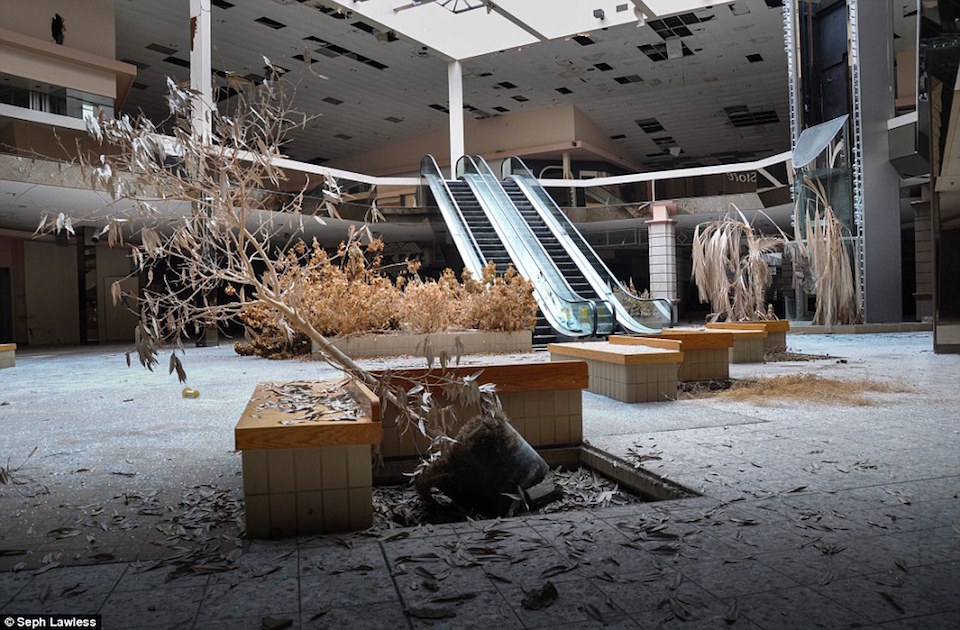Thousands of stores are closing, and there is talk of the retail apocalypse: how can this change be tackled?
- 30 August 2017
- Alessandro Tazzioli

An abandoned shopping mall: Rolling Acres Mall in Ohio (an image from Seph Lawless’s book “The Collapse of the American Shopping Mall“, available here http://bit.ly/2veTfPa )
It is estimated that of the 1,200 malls currently open in the United States of America, 50% will be closed by 2023.
50%, 1 out of every 2. This estimate may seem incredible, but is in line with what has been occurring in the US since the end of 2016, with a significant number of stores closing at a pace never seen before, to the point where the expression “retail apocalypse” was coined to define the phenomenon.
More than 4,000 stores have already closed and many more will in the coming years: who is to blame? The cause is often attributed to the reduced purchasing power of the middle class: who have less and less resources available for purchases, and higher costs for education, health, and the home.
This reduction in purchasing power is added to millennials’ change of interests and tastes, as they increasingly look for and buy products online that help them build their identity, starting with clothing, where they prefer a more personal, distinctive style.
The high number of closures not only has an impact on the people who worked in these stores and their related services, but also on the entire urban fabric, which suddenly includes enormous, deserted buildings which are more often than not difficult to reclassify.
The scenario in which a traditional shopkeeper must currently work in is truly complicated.
If a quick online search shows that it is possible to buy the same product sold in the store around the corner at a lower price, perhaps with the ability to have it delivered where it is needed within a couple of hours or at the most within one day, what could possibly favor purchasing it at the store?
Perhaps the store around the corner has an alternative at a lower cost or an extra service, but how many stores today put their inventory online to let those nearby know what they’ll find when they get to the store?
This results in imbalanced information, which creates a significant disadvantage to the traditional shopkeeper: they publish very little information, compared to e-commerce, which publishes an exaggerated amount.
In addition, those who have a physical store are victims of the phenomenon known as show-rooming: people use the shop to find the most suitable product (i.e. the right size pair of shoes) and then buy it online, leaving the shopkeeper to handle the showroom costs without the relative earnings.
Shopkeepers who complain about show-rooming will soon have to deal with the spread of body scanner solutions, like those offered by Styku or Bodi.me (to name just a few), which will eventually make a visit to a store totally superfluous.
These current trends can be partially mitigated by various means:
For example, meeting the millennial’s desire to customize, you can offer specific proposals in a single store that cannot be purchased online or in other stores.
You can publish real-time availability at your store and put “price-matching” mechanisms into effect, thus offering an incentive for those nearby to choose your store.
You could also turn your individual store or shopping mall into a pick-up point for online purchases, optimizing logistics costs, and thus providing an extra reason for people to come in.
Another idea? Install parcel lockers to manage customer returns, who can then avoid re-packing the item to be returned, scheduling pick-up, etc.
The WIB locker designed and manufactured for Coop
One opportunity for brands to stay close to their customers (potential and already acquired) is to use real automated smart stores, which in a certain sense represent an evolution of the shop-in-shop trend. The opportunity offers several advantages:
-
It creates brand perception continuity, providing a point of visibility and additional contact (also thanks to digital signage displays, wi-fi hotspots, and other technical solutions).
-
There are no costs like in a traditional store, allowing the same investment to cover more of the market.
-
It lets you get closer to the consumer in the moment when their impulse to buy is the strongest: remember that not all cities have 1-hour deliveries, and even in this case the selection is limited, as it is more common for delivery to take 1 or 2 days.
-
Availability at the single store can be easily integrated with the brand’s site or app, as well as external price comparison sites and other high visibility online sites.
-
It makes it easy to extend business hours: for example, supermarkets can cover up to 24 hours (not with all their products, of course, but they can still provide an additional service).
Thanks to ever-faster internet connections and the spread of smartphones, brands who want to can still offer the human contact of a salesperson through videoconferencing solutions, helping people with their requests, and thus offering an even more positive point of contact.
“Automated stores” are not an absolute answer to the ongoing changes, but they can be an important resource for brands and shopkeepers.
Addressing the retail apocalypse requires identifying the key aspects of customer relations from all perspectives, optimizing costs, maximizing the value of each contact point and duration, recognizing the changing expectations of customers (who increasingly want to have a seamless buying experience), and being able to meet these demands.
Brendan Witcher, a chief analyst at Forrester, also points out another reason behind the large retailers’ crisis in the United States: their inability to meet customer expectations by not adequately caring for shopping experience quality.
Recovering resources to best handle this change is not easy, even if the automation of production processes seems to offer good prospects.
Adidas, for example, is manufacturing new high-automation production lines that can make around 800,000 T-shirts a day with negligible labor costs: in this case, the savings in production could help with the upgrading of the distribution network, ensuring greater coverage.
Adidas’s choice may not be appropriate for other companies, but one fundamental certainty remains: in the face of such radical changes, standing still and doing “what has always been done” is probably the worst possible choice.




